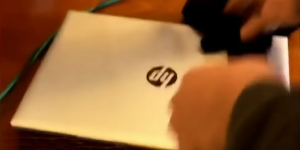“We’re looking for Nancy Pelosi’s laptop,” FBI agents told innkeeper Marilyn Hueper after briefly handcuffing her.

Hueper shot back: “That still doesn’t explain why you’re in my home. Or in Homer, Alaska.”
The search for the House speaker’s laptop had taken a U.S. Capitol Police officer thousands of miles away from home for an FBI raid on Hueper’s home and business, the Homer Inn and Spa, looking for something allegedly stolen during the Jan. 6 uprising—and the person who did it.
After detaining the Huepers and several houseguests, including a teenager, by forcing them to wear handcuffs during the raid, the agents would walk out of Hueper’s home with iPads, cellphones and a pocket-size copy of the Declaration of Independence.
They took a laptop, but it wasn’t from Pelosi’s office. And it’s possible they may have the wrong person altogether—even though they claimed Hueper looks strikingly similar to the suspected thief.
The Justice Department’s massive prosecution of those who stormed the U.S. Capitol on Jan. 6 has not been without its problems, including this potential instance of mistaken identity.
Given the alarming overreach of DOJ officials, paired with the over-the-top partisan rhetoric attempting to hype up the mostly peaceful protest, any missteps by federal prosecutors could further damage their credibility, already pushed far beyond the brink.
Biden-administration prosecutors have charged more than 400 people, the largest undertaking by the department, including scores of defendants who posted images of their crimes online and boasted about breaking into the hallowed building, which followed months of inaction surrounding left-wing riots and attacks on government buildings.
Many believed the demonstration was constitutionally protected under the First Amendment freedoms to assemble and petition the government for redress of grievances—particularly as Capitol Police appeared to welcome them into the public building and to direct traffic.
The mood quickly changed, however, after an unknown Capital Police officer shot and killed Air Force veteran Ashli Babbitt, who was attempting to enter the House Speaker’s Lobby via a broken window.
While the DOJ determined that the killer acted within reason, some of the pro-Trump dissidents are facing serious charges and considerable prison time.
Hueper and her husband first came to officials’ attention this year when Alaska Airlines in February banned the couple for refusing to wear masks on a flight, according to court documents.
Then two other people called in tips saying they recognized Hueper in photos that authorities had released of suspects wanted for storming the Capitol.

It is not known whether they were among the group that ransacked offices, rifled through lawmakers’ papers and desks, smashed through glass, shattered windows and tore down signs.
Among the items allegedly stolen: the laptop from Pelosi’s office, her lectern, an iPad belonging to Majority Whip Rep. Jim Clyburn and other electronics.
However, there also have been some false claims concerning the damage. Rep. Ayanna Pressley blamed demonstrators for ripping the “panic” buttons from her office prior to the so-called siege.
But after the claim proved false, she stealth edited the tweet to remove the absurd allegation.
Donald J. Trump should immediately be impeached by the House of Representatives & removed from office by the United States Senate as soon as Congress reconvenes.
TEvery panic button in my office had been torn out — the whole unithis is dangerous & unacceptable.
— Ayanna Pressley (@AyannaPressley) January 6, 2021
The volume of people inside the Capitol building, along with the lack of arrests made at the time of the riot, has made it difficult to identify people, even with the glut of social media evidence.
Federal agents have dug through thousands of social media posts, gotten sweeping warrants to obtain information on cellphones in the area of the Capitol, used facial recognition tools and obtained logs of devices that signed into the congressional Wi-Fi during the riot.
But by far the most effective tool for federal agents has been old-fashioned tips. Many of the rioters have been ratted out by their friends and family members.
The warrant identifies Hueper as the woman who took the laptop.
But they’re wrong, Hueper insists.

She told the AP that another woman wearing her same coat and with a similar hairstyle was inside the Capitol during the insurrection, not her.
She admits she was in Washington, DC, for Trump’s rally that day, but says she didn’t get any closer than 100 yards from the Capitol and spent part of the day being lost in an unfamiliar city.
She said agents showed her one photo of the woman inside the Capitol, and they looked so similar that Hueper wondered if someone had used photo-editing software to put her in the photograph.
The warrant details how FBI agents located an image showing Hueper wearing similar clothing in a photo on her husband’s Instagram account.
It said Hueper’s husband had also posted photos of them near the Capitol.
“BEST OF 2020,” he wrote in one, showing her from behind nearing the building. “Marilyn approaching the Capital [sic]. As Patriots, there is a righteous revolution to take back our country … To be there was a once-in-a-lifetime experience. STOP THE STEAL!”
Hueper said an agent came back with a different and larger photo of the woman, which showed the suspected thief wearing a black sweater with large white snowflakes on it. The agent asked where in the house they could locate the sweater.
Hueper said she reiterated she wasn’t inside the building. “No. 2, why didn’t you show me this photo to start with? Because we can both obviously see here this is a different person.”
Plus, she said, the sweater was hideous.
Hueper said she grabbed the photo and held it next to her face, asking the female agent to look at both closely, “Me. Her. Me. Her,” she told the agent.
Hueper said the agent grabbed the paper and walked off.
Both women were wearing black Columbia down coats. However, in a photo posted on her husband’s Facebook page from Jan. 6, Hueper is shown wearing a black face mask, a green blouse open at the collar and a light green scarf.
The surveillance video released by the FBI shows the sought-after woman wearing the black sweater with a snowflake print and dangling earrings. Also, the woman in the photo has detached earlobes, while Hueper says hers are attached.
After insisting, Hueper was shown the front page of the warrant but not allowed to thoroughly read the document, she said.
She read it only after receiving a copy as the dozen or so agents and Capitol Police officer left.
According to the search warrants, agents could collect any electronics that might be suspected to have been involved, items stolen from the Capitol, a laptop with descriptors and a serial number—“which they didn’t find,” she said—and any paperwork related to planning violence.
Hueper said she has not heard back from federal authorities, nor have agents returned her laptop, two iPads, two cellphones or the 50-cent pocket-size Declaration of Independence booklet they confiscated April 28.
She has not been arrested. Justice Department officials would say only that the investigation is ongoing.
But she decided to go public with her story, just in case.
“I better go online and protect myself before they call me in and make me this person,” she said.
Adapted from reporting by the Associated Press

